Do you have a question about the Siemens iQ300 KA N Series and is the answer not in the manual?
| Type | Freestanding |
|---|---|
| Frost Free | Yes |
| Freezing Capacity | 4.5 kg/24h |
| Climate Class | SN-T |
| Reversible Doors | Yes |
| Number of Compressors | 1 |
| Number of Doors | 2 |
| Control Type | Electronic |
| Defrost System | Automatic |
| Door Hinge | Right |
| Color | White |
Read operating and installation instructions carefully for important safety information.
Covers refrigerant hazards, potential ignition risks, and damage protocols.
Actions to take if appliance is damaged, including ventilation and customer service notification.
General warnings on safe usage, electrical safety, and appliance limitations.
Guidelines for ensuring the safety of children and vulnerable individuals around the appliance.
Warning regarding suffocation hazards from packaging materials like cartons and film.
Strict prohibition against children playing with the appliance to prevent accidents.
Instruction to store the appliance key safely away from children.
Appliance is suitable for refrigerating, freezing food, and making ice.
Specifies the appliance's intended use in a domestic environment.
Appliance complies with EU directive on electromagnetic compatibility.
Confirmation that the appliance's refrigeration circuit has undergone leak testing.
Product adheres to safety regulations for electrical appliances, specifically EN 60335-2-24.
Specifies the maximum altitude for safe and effective appliance operation.
Guidance on environmentally friendly disposal of appliance packaging materials.
Information on recycling old appliances and compliance with WEEE directive.
Instructions for disabling redundant appliances before disposal to prevent hazards.
Advise to inspect all parts for transit damage immediately after unpacking.
Lists the components included in the appliance package upon delivery.
Safety measures for transporting and installing the heavy appliance, requiring at least two people.
Recommendations for selecting a dry, well-ventilated location, away from heat sources.
Ensuring the installation floor can support the appliance's weight and is stable.
Importance of correct ambient temperature and unimpeded ventilation for optimal performance.
Identification and overview of the freezer compartment components.
Identification and overview of the refrigerator compartment components.
Explanation of the freezer compartment's display and control functions.
Explanation of the refrigerator compartment's display and control functions.
Describes the function of the temperature adjustment buttons.
Details the 'Fresh' button's function for enhancing food shelf life.
Explains the 'eco' button for activating the energy-saving mode.
Step-by-step guide to setting the desired temperature for the freezer.
Step-by-step guide to setting the desired temperature for the refrigerator.
Explains the door alarm and how to silence it.
Describes the temperature alarm and when it activates for food safety.
Details the 'Fresh' mode for improved food preservation.
Explains the energy-saving 'eco' mode.
Describes the 'Vacation' mode for energy saving during absences.
Outlines the primary uses of the freezer compartment.
Important notes on proper freezer door closure and pressure equalization.
Advice on selecting and transporting frozen food items.
Keep freshly frozen food separate from already frozen items.
Lists various food types recommended for freezing.
Lists food types that should not be frozen.
Lists appropriate materials for packaging frozen food.
Lists packaging materials unsuitable for frozen food.
Lists items used for sealing food packaging.
Notes potential increase in operating noise during super freezing.
Detailed instructions for activating and deactivating the super freezing function.
Warning against refreezing thawed food; only cooked meals can be refrozen.
Guidelines for storing food to maintain quality and freshness.
Avoid contact between food and the rear panel to ensure air circulation.
Explains the different temperature zones within the refrigerator.
Notes on storing cold-sensitive produce and managing condensation.
Notes potential increase in operating noise during super cooling.
Detailed instructions for activating and deactivating the super cooling function.
Steps to turn off the appliance using the plug or fuse.
Procedures for disconnecting the appliance for long periods.
States freezer compartment is frost-free due to NoFrost technology.
Explains automatic defrosting process in the refrigerator compartment.
Warning against using steam cleaners for appliance maintenance.
Cautions against abrasive cleaners and dishwashers for parts.
Step-by-step guide for safely cleaning the appliance interior and exterior.
Identifies common, normal operational sounds like droning and bubbling.
Tips to prevent or minimize operational noises related to installation and placement.
Contact details for requesting repairs and obtaining advice on faults.
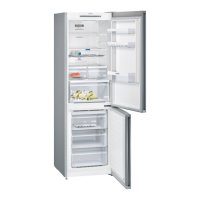

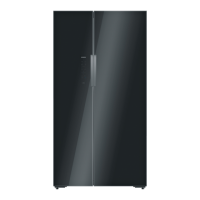
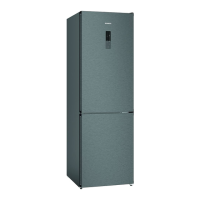
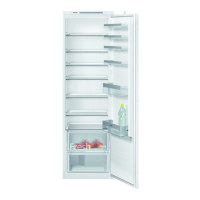

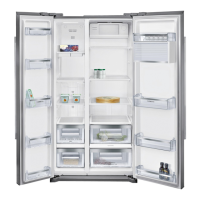


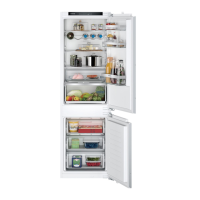


